PAM006 - Blockchain Technology and its Impact on Big 4 Audit Firms
VerifiedAdded on 2023/04/08
|17
|2887
|357
Project
AI Summary
This project examines the impact of blockchain technology on the Big Four audit firms (PWC, KPMG, EY, and Deloitte) in the Middle East. It begins by introducing blockchain technology as a peer-to-peer, internet-based distributed ledger for capturing transactions and explores its characteristics, advantages, and disadvantages. The project investigates how blockchain technology can affect audit firms, particularly in areas like financial statement preparation and data accessibility. It also addresses the potential for increased efficiency and reduced time lags in financial reporting. The research methodology employs a deductive approach, using existing research to analyze the impact of blockchain technology on the Big Four audit firms, highlighting the gap in previous research and emphasizing the study's focus on the audit industry. Desklib provides access to this and other solved assignments for students.
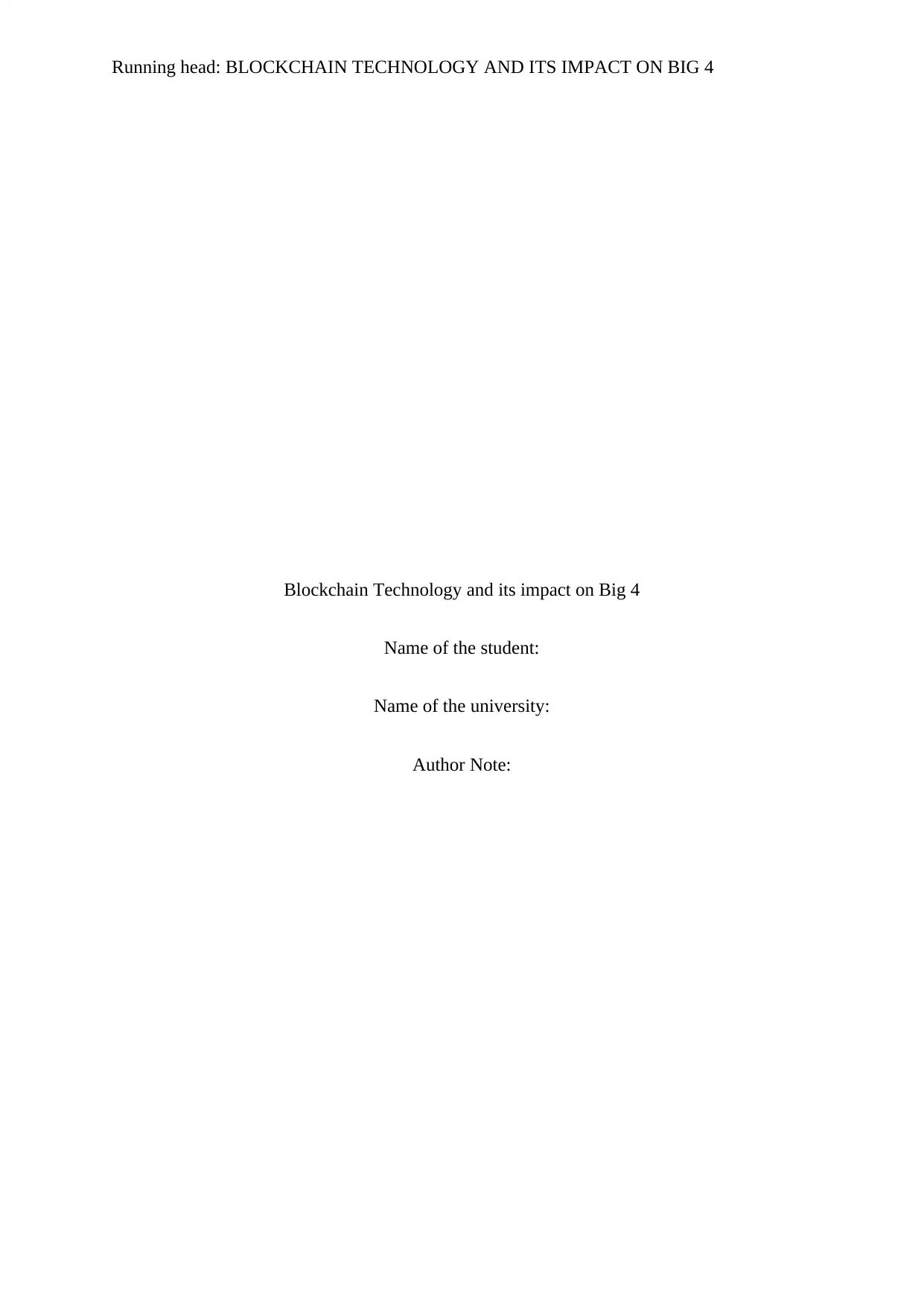
Running head: BLOCKCHAIN TECHNOLOGY AND ITS IMPACT ON BIG 4
Blockchain Technology and its impact on Big 4
Name of the student:
Name of the university:
Author Note:
Blockchain Technology and its impact on Big 4
Name of the student:
Name of the university:
Author Note:
Paraphrase This Document
Need a fresh take? Get an instant paraphrase of this document with our AI Paraphraser
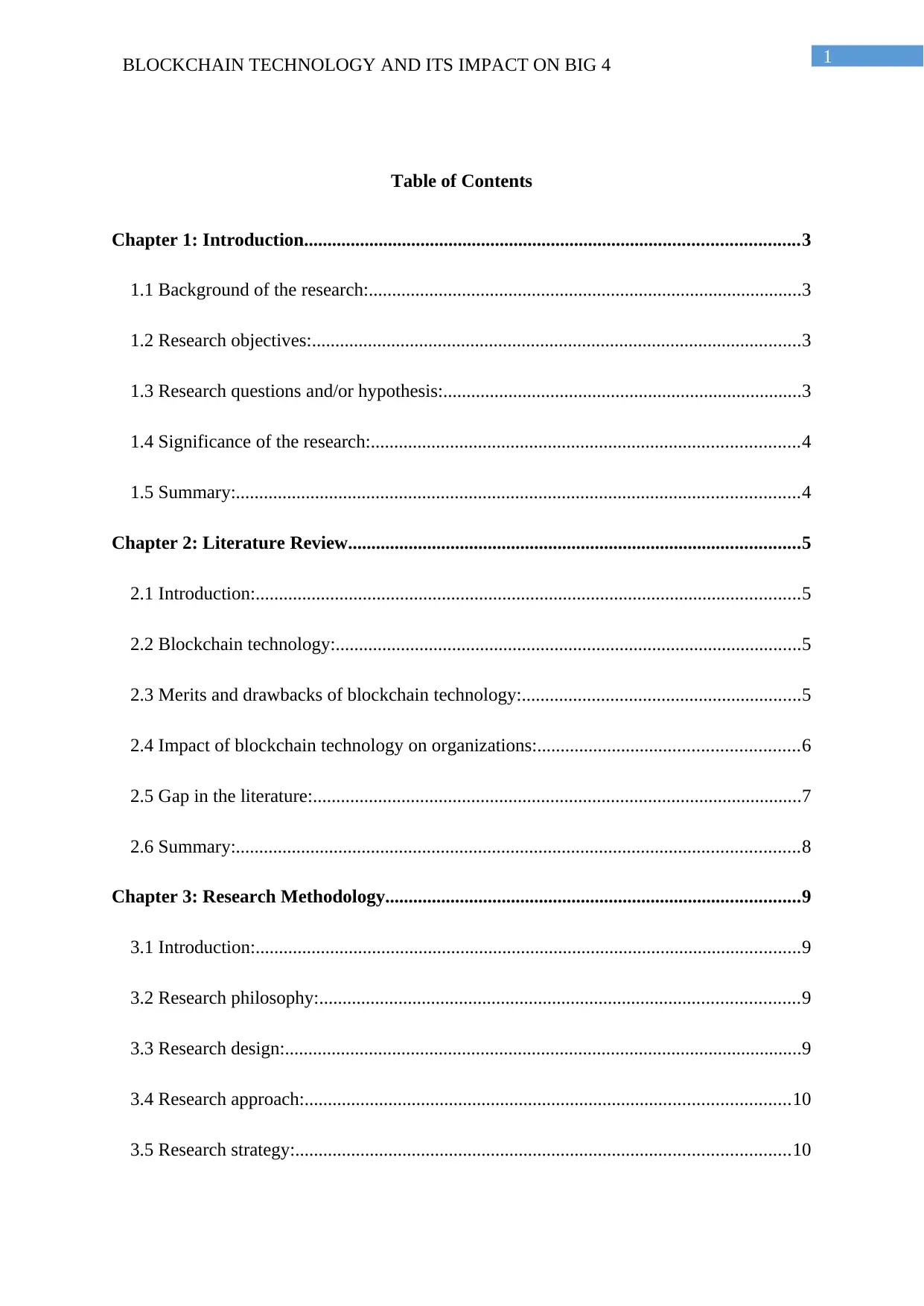
1BLOCKCHAIN TECHNOLOGY AND ITS IMPACT ON BIG 4
Table of Contents
Chapter 1: Introduction..........................................................................................................3
1.1 Background of the research:.............................................................................................3
1.2 Research objectives:.........................................................................................................3
1.3 Research questions and/or hypothesis:.............................................................................3
1.4 Significance of the research:............................................................................................4
1.5 Summary:.........................................................................................................................4
Chapter 2: Literature Review.................................................................................................5
2.1 Introduction:.....................................................................................................................5
2.2 Blockchain technology:....................................................................................................5
2.3 Merits and drawbacks of blockchain technology:............................................................5
2.4 Impact of blockchain technology on organizations:........................................................6
2.5 Gap in the literature:.........................................................................................................7
2.6 Summary:.........................................................................................................................8
Chapter 3: Research Methodology.........................................................................................9
3.1 Introduction:.....................................................................................................................9
3.2 Research philosophy:.......................................................................................................9
3.3 Research design:...............................................................................................................9
3.4 Research approach:........................................................................................................10
3.5 Research strategy:..........................................................................................................10
Table of Contents
Chapter 1: Introduction..........................................................................................................3
1.1 Background of the research:.............................................................................................3
1.2 Research objectives:.........................................................................................................3
1.3 Research questions and/or hypothesis:.............................................................................3
1.4 Significance of the research:............................................................................................4
1.5 Summary:.........................................................................................................................4
Chapter 2: Literature Review.................................................................................................5
2.1 Introduction:.....................................................................................................................5
2.2 Blockchain technology:....................................................................................................5
2.3 Merits and drawbacks of blockchain technology:............................................................5
2.4 Impact of blockchain technology on organizations:........................................................6
2.5 Gap in the literature:.........................................................................................................7
2.6 Summary:.........................................................................................................................8
Chapter 3: Research Methodology.........................................................................................9
3.1 Introduction:.....................................................................................................................9
3.2 Research philosophy:.......................................................................................................9
3.3 Research design:...............................................................................................................9
3.4 Research approach:........................................................................................................10
3.5 Research strategy:..........................................................................................................10

2BLOCKCHAIN TECHNOLOGY AND ITS IMPACT ON BIG 4
3.6 Data collection and analysis:..........................................................................................10
3.7 Sampling and sample size:.............................................................................................10
3.8 Ethical considerations:...................................................................................................11
3.9 Summary:.......................................................................................................................11
3.6 Data collection and analysis:..........................................................................................10
3.7 Sampling and sample size:.............................................................................................10
3.8 Ethical considerations:...................................................................................................11
3.9 Summary:.......................................................................................................................11
⊘ This is a preview!⊘
Do you want full access?
Subscribe today to unlock all pages.

Trusted by 1+ million students worldwide
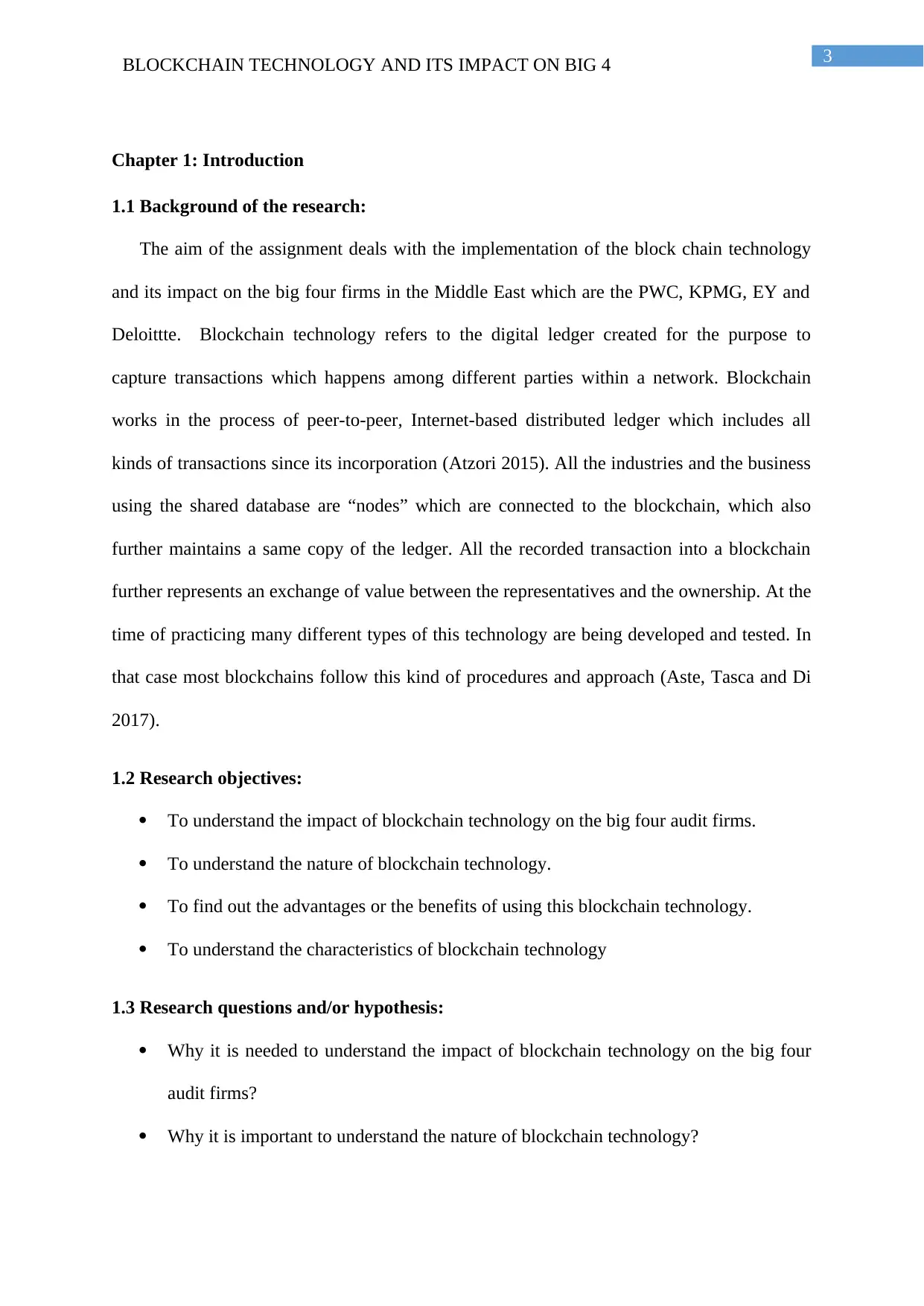
3BLOCKCHAIN TECHNOLOGY AND ITS IMPACT ON BIG 4
Chapter 1: Introduction
1.1 Background of the research:
The aim of the assignment deals with the implementation of the block chain technology
and its impact on the big four firms in the Middle East which are the PWC, KPMG, EY and
Deloittte. Blockchain technology refers to the digital ledger created for the purpose to
capture transactions which happens among different parties within a network. Blockchain
works in the process of peer-to-peer, Internet-based distributed ledger which includes all
kinds of transactions since its incorporation (Atzori 2015). All the industries and the business
using the shared database are “nodes” which are connected to the blockchain, which also
further maintains a same copy of the ledger. All the recorded transaction into a blockchain
further represents an exchange of value between the representatives and the ownership. At the
time of practicing many different types of this technology are being developed and tested. In
that case most blockchains follow this kind of procedures and approach (Aste, Tasca and Di
2017).
1.2 Research objectives:
To understand the impact of blockchain technology on the big four audit firms.
To understand the nature of blockchain technology.
To find out the advantages or the benefits of using this blockchain technology.
To understand the characteristics of blockchain technology
1.3 Research questions and/or hypothesis:
Why it is needed to understand the impact of blockchain technology on the big four
audit firms?
Why it is important to understand the nature of blockchain technology?
Chapter 1: Introduction
1.1 Background of the research:
The aim of the assignment deals with the implementation of the block chain technology
and its impact on the big four firms in the Middle East which are the PWC, KPMG, EY and
Deloittte. Blockchain technology refers to the digital ledger created for the purpose to
capture transactions which happens among different parties within a network. Blockchain
works in the process of peer-to-peer, Internet-based distributed ledger which includes all
kinds of transactions since its incorporation (Atzori 2015). All the industries and the business
using the shared database are “nodes” which are connected to the blockchain, which also
further maintains a same copy of the ledger. All the recorded transaction into a blockchain
further represents an exchange of value between the representatives and the ownership. At the
time of practicing many different types of this technology are being developed and tested. In
that case most blockchains follow this kind of procedures and approach (Aste, Tasca and Di
2017).
1.2 Research objectives:
To understand the impact of blockchain technology on the big four audit firms.
To understand the nature of blockchain technology.
To find out the advantages or the benefits of using this blockchain technology.
To understand the characteristics of blockchain technology
1.3 Research questions and/or hypothesis:
Why it is needed to understand the impact of blockchain technology on the big four
audit firms?
Why it is important to understand the nature of blockchain technology?
Paraphrase This Document
Need a fresh take? Get an instant paraphrase of this document with our AI Paraphraser
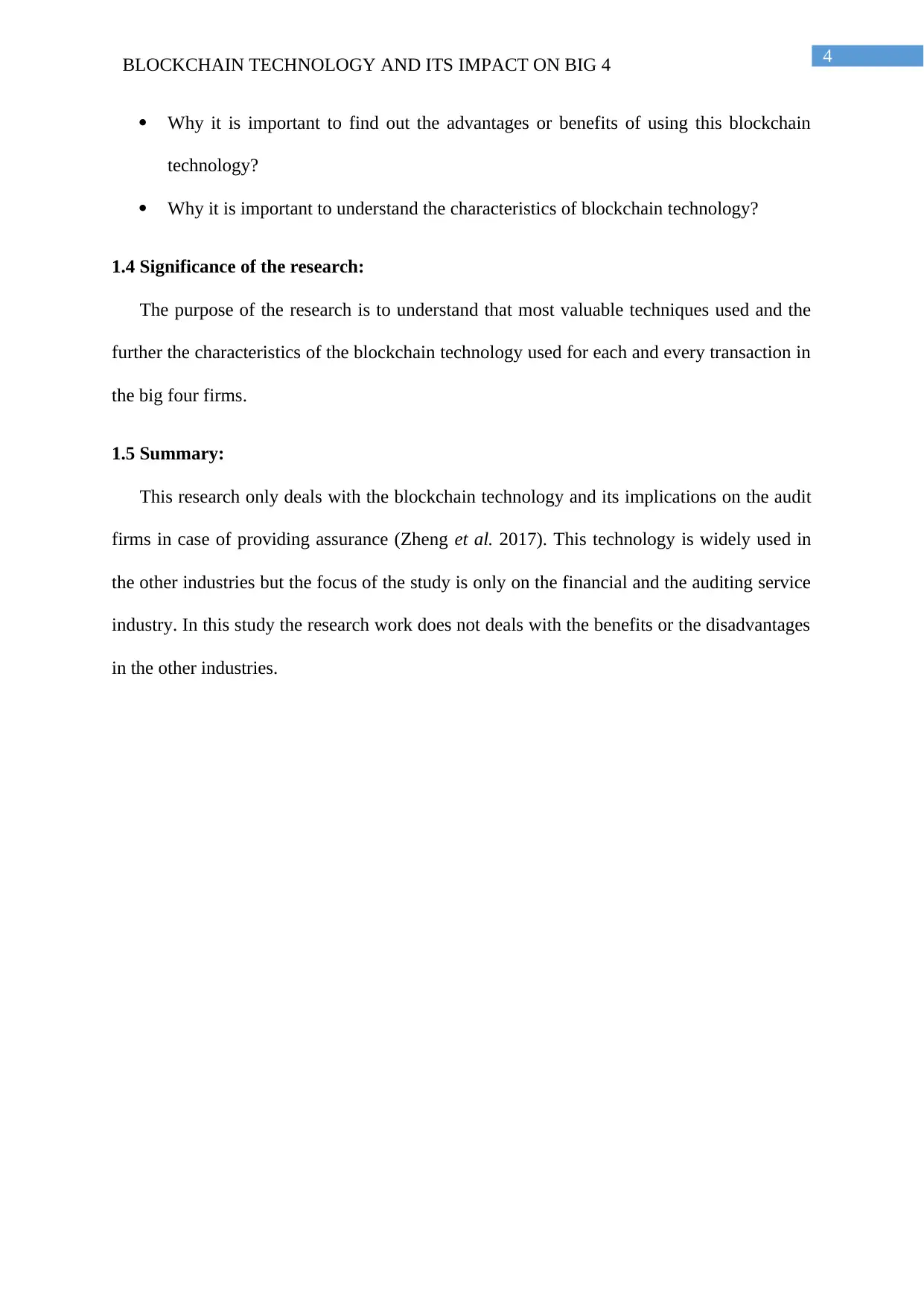
4BLOCKCHAIN TECHNOLOGY AND ITS IMPACT ON BIG 4
Why it is important to find out the advantages or benefits of using this blockchain
technology?
Why it is important to understand the characteristics of blockchain technology?
1.4 Significance of the research:
The purpose of the research is to understand that most valuable techniques used and the
further the characteristics of the blockchain technology used for each and every transaction in
the big four firms.
1.5 Summary:
This research only deals with the blockchain technology and its implications on the audit
firms in case of providing assurance (Zheng et al. 2017). This technology is widely used in
the other industries but the focus of the study is only on the financial and the auditing service
industry. In this study the research work does not deals with the benefits or the disadvantages
in the other industries.
Why it is important to find out the advantages or benefits of using this blockchain
technology?
Why it is important to understand the characteristics of blockchain technology?
1.4 Significance of the research:
The purpose of the research is to understand that most valuable techniques used and the
further the characteristics of the blockchain technology used for each and every transaction in
the big four firms.
1.5 Summary:
This research only deals with the blockchain technology and its implications on the audit
firms in case of providing assurance (Zheng et al. 2017). This technology is widely used in
the other industries but the focus of the study is only on the financial and the auditing service
industry. In this study the research work does not deals with the benefits or the disadvantages
in the other industries.
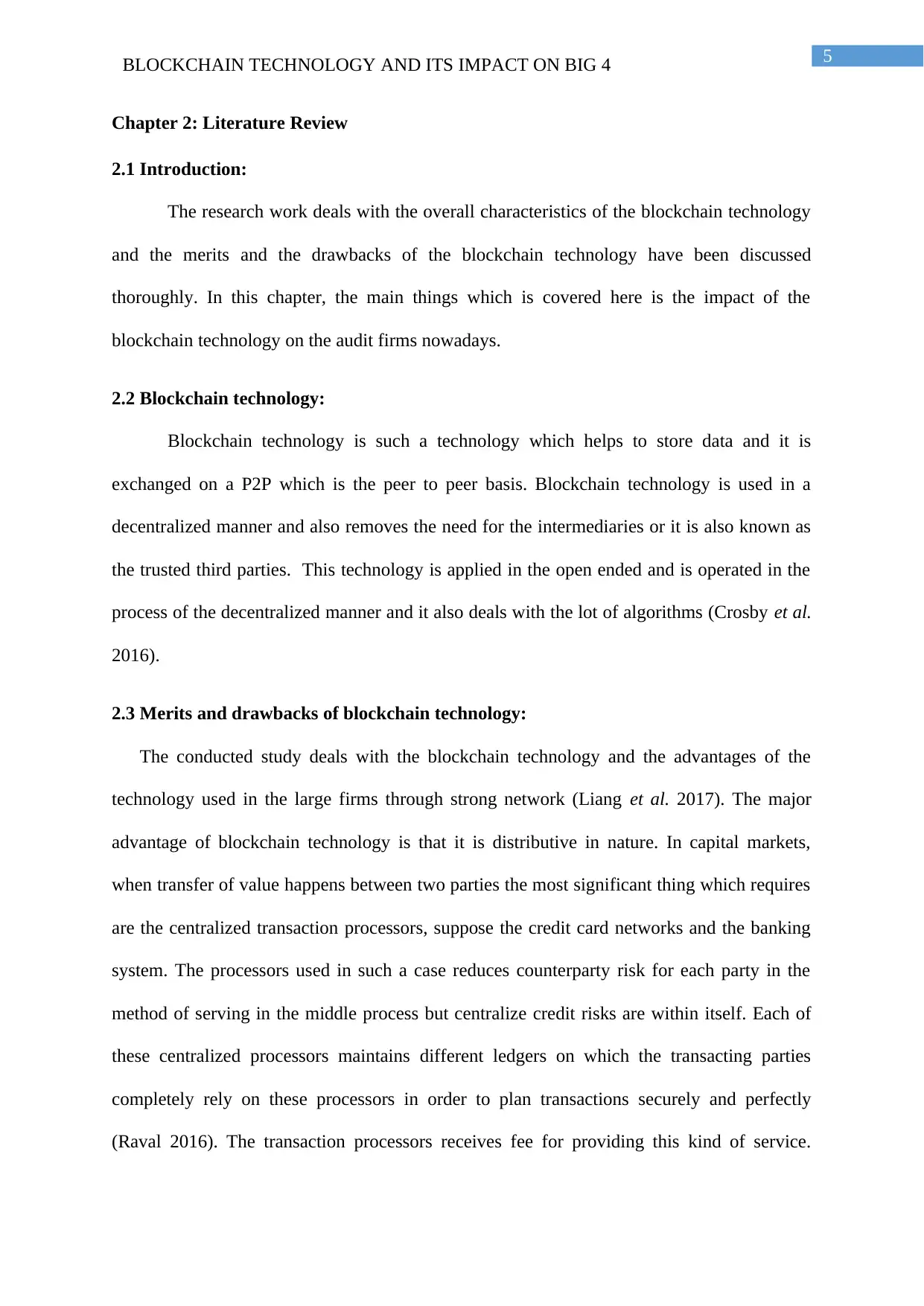
5BLOCKCHAIN TECHNOLOGY AND ITS IMPACT ON BIG 4
Chapter 2: Literature Review
2.1 Introduction:
The research work deals with the overall characteristics of the blockchain technology
and the merits and the drawbacks of the blockchain technology have been discussed
thoroughly. In this chapter, the main things which is covered here is the impact of the
blockchain technology on the audit firms nowadays.
2.2 Blockchain technology:
Blockchain technology is such a technology which helps to store data and it is
exchanged on a P2P which is the peer to peer basis. Blockchain technology is used in a
decentralized manner and also removes the need for the intermediaries or it is also known as
the trusted third parties. This technology is applied in the open ended and is operated in the
process of the decentralized manner and it also deals with the lot of algorithms (Crosby et al.
2016).
2.3 Merits and drawbacks of blockchain technology:
The conducted study deals with the blockchain technology and the advantages of the
technology used in the large firms through strong network (Liang et al. 2017). The major
advantage of blockchain technology is that it is distributive in nature. In capital markets,
when transfer of value happens between two parties the most significant thing which requires
are the centralized transaction processors, suppose the credit card networks and the banking
system. The processors used in such a case reduces counterparty risk for each party in the
method of serving in the middle process but centralize credit risks are within itself. Each of
these centralized processors maintains different ledgers on which the transacting parties
completely rely on these processors in order to plan transactions securely and perfectly
(Raval 2016). The transaction processors receives fee for providing this kind of service.
Chapter 2: Literature Review
2.1 Introduction:
The research work deals with the overall characteristics of the blockchain technology
and the merits and the drawbacks of the blockchain technology have been discussed
thoroughly. In this chapter, the main things which is covered here is the impact of the
blockchain technology on the audit firms nowadays.
2.2 Blockchain technology:
Blockchain technology is such a technology which helps to store data and it is
exchanged on a P2P which is the peer to peer basis. Blockchain technology is used in a
decentralized manner and also removes the need for the intermediaries or it is also known as
the trusted third parties. This technology is applied in the open ended and is operated in the
process of the decentralized manner and it also deals with the lot of algorithms (Crosby et al.
2016).
2.3 Merits and drawbacks of blockchain technology:
The conducted study deals with the blockchain technology and the advantages of the
technology used in the large firms through strong network (Liang et al. 2017). The major
advantage of blockchain technology is that it is distributive in nature. In capital markets,
when transfer of value happens between two parties the most significant thing which requires
are the centralized transaction processors, suppose the credit card networks and the banking
system. The processors used in such a case reduces counterparty risk for each party in the
method of serving in the middle process but centralize credit risks are within itself. Each of
these centralized processors maintains different ledgers on which the transacting parties
completely rely on these processors in order to plan transactions securely and perfectly
(Raval 2016). The transaction processors receives fee for providing this kind of service.
⊘ This is a preview!⊘
Do you want full access?
Subscribe today to unlock all pages.

Trusted by 1+ million students worldwide
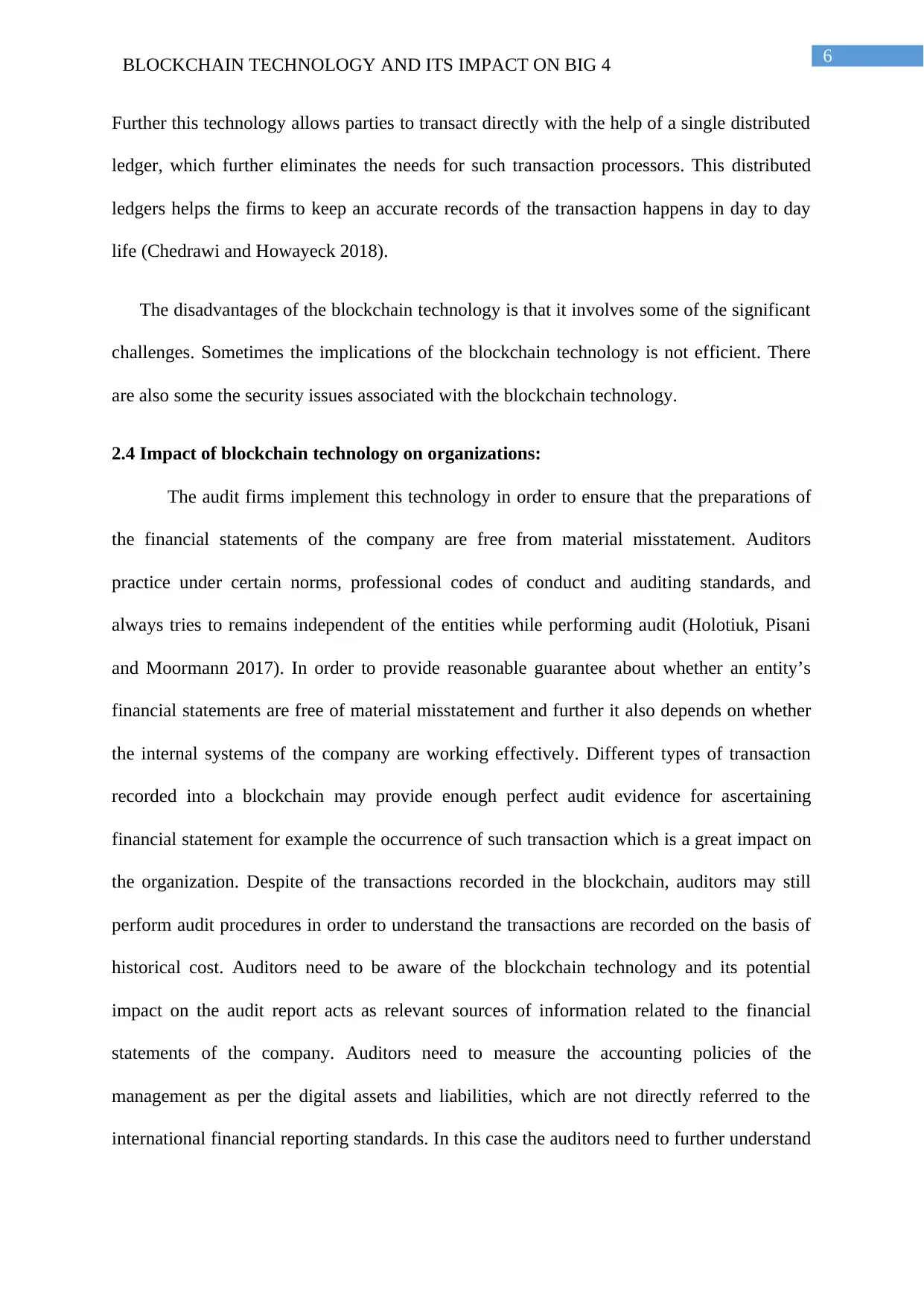
6BLOCKCHAIN TECHNOLOGY AND ITS IMPACT ON BIG 4
Further this technology allows parties to transact directly with the help of a single distributed
ledger, which further eliminates the needs for such transaction processors. This distributed
ledgers helps the firms to keep an accurate records of the transaction happens in day to day
life (Chedrawi and Howayeck 2018).
The disadvantages of the blockchain technology is that it involves some of the significant
challenges. Sometimes the implications of the blockchain technology is not efficient. There
are also some the security issues associated with the blockchain technology.
2.4 Impact of blockchain technology on organizations:
The audit firms implement this technology in order to ensure that the preparations of
the financial statements of the company are free from material misstatement. Auditors
practice under certain norms, professional codes of conduct and auditing standards, and
always tries to remains independent of the entities while performing audit (Holotiuk, Pisani
and Moormann 2017). In order to provide reasonable guarantee about whether an entity’s
financial statements are free of material misstatement and further it also depends on whether
the internal systems of the company are working effectively. Different types of transaction
recorded into a blockchain may provide enough perfect audit evidence for ascertaining
financial statement for example the occurrence of such transaction which is a great impact on
the organization. Despite of the transactions recorded in the blockchain, auditors may still
perform audit procedures in order to understand the transactions are recorded on the basis of
historical cost. Auditors need to be aware of the blockchain technology and its potential
impact on the audit report acts as relevant sources of information related to the financial
statements of the company. Auditors need to measure the accounting policies of the
management as per the digital assets and liabilities, which are not directly referred to the
international financial reporting standards. In this case the auditors need to further understand
Further this technology allows parties to transact directly with the help of a single distributed
ledger, which further eliminates the needs for such transaction processors. This distributed
ledgers helps the firms to keep an accurate records of the transaction happens in day to day
life (Chedrawi and Howayeck 2018).
The disadvantages of the blockchain technology is that it involves some of the significant
challenges. Sometimes the implications of the blockchain technology is not efficient. There
are also some the security issues associated with the blockchain technology.
2.4 Impact of blockchain technology on organizations:
The audit firms implement this technology in order to ensure that the preparations of
the financial statements of the company are free from material misstatement. Auditors
practice under certain norms, professional codes of conduct and auditing standards, and
always tries to remains independent of the entities while performing audit (Holotiuk, Pisani
and Moormann 2017). In order to provide reasonable guarantee about whether an entity’s
financial statements are free of material misstatement and further it also depends on whether
the internal systems of the company are working effectively. Different types of transaction
recorded into a blockchain may provide enough perfect audit evidence for ascertaining
financial statement for example the occurrence of such transaction which is a great impact on
the organization. Despite of the transactions recorded in the blockchain, auditors may still
perform audit procedures in order to understand the transactions are recorded on the basis of
historical cost. Auditors need to be aware of the blockchain technology and its potential
impact on the audit report acts as relevant sources of information related to the financial
statements of the company. Auditors need to measure the accounting policies of the
management as per the digital assets and liabilities, which are not directly referred to the
international financial reporting standards. In this case the auditors need to further understand
Paraphrase This Document
Need a fresh take? Get an instant paraphrase of this document with our AI Paraphraser
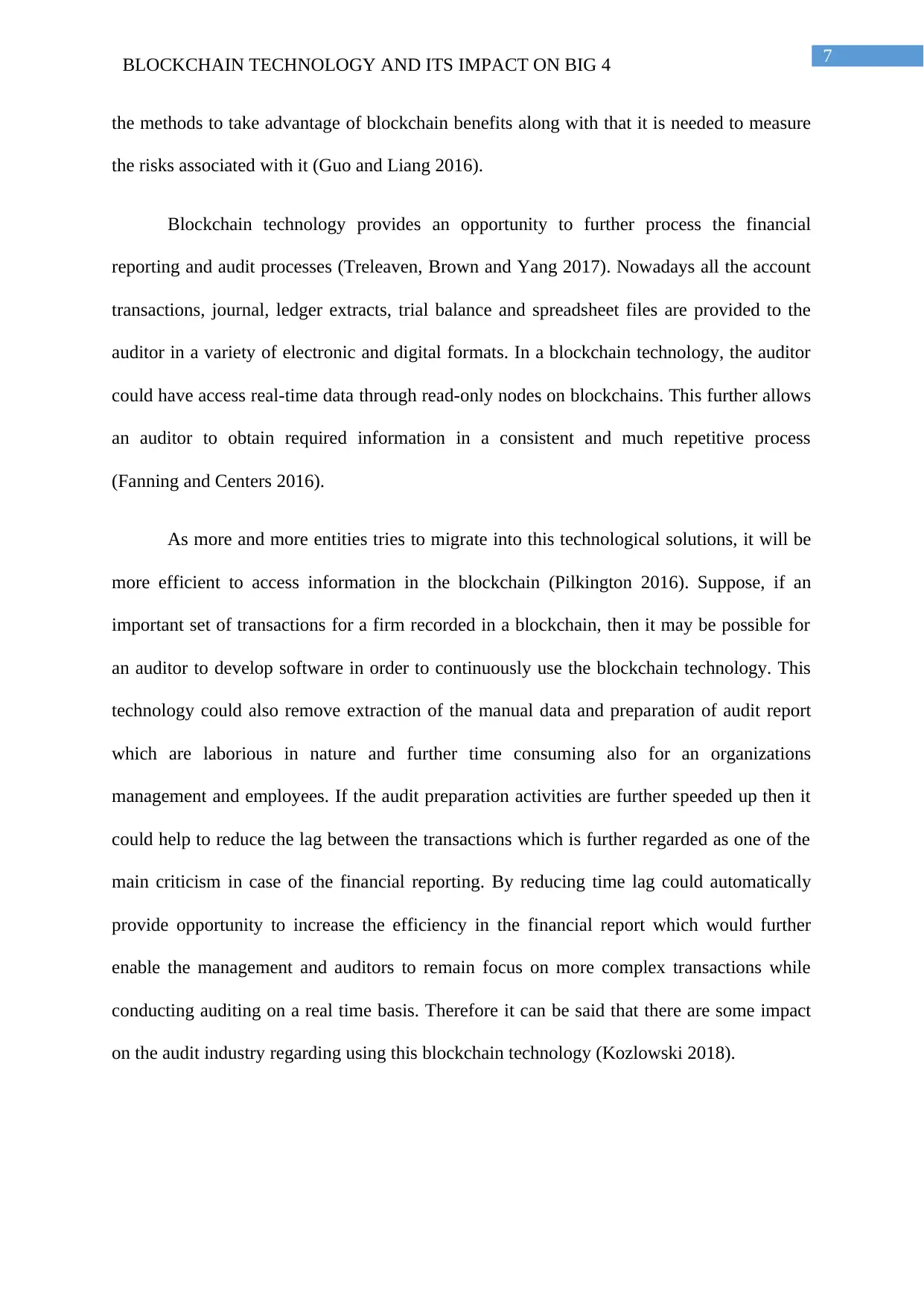
7BLOCKCHAIN TECHNOLOGY AND ITS IMPACT ON BIG 4
the methods to take advantage of blockchain benefits along with that it is needed to measure
the risks associated with it (Guo and Liang 2016).
Blockchain technology provides an opportunity to further process the financial
reporting and audit processes (Treleaven, Brown and Yang 2017). Nowadays all the account
transactions, journal, ledger extracts, trial balance and spreadsheet files are provided to the
auditor in a variety of electronic and digital formats. In a blockchain technology, the auditor
could have access real-time data through read-only nodes on blockchains. This further allows
an auditor to obtain required information in a consistent and much repetitive process
(Fanning and Centers 2016).
As more and more entities tries to migrate into this technological solutions, it will be
more efficient to access information in the blockchain (Pilkington 2016). Suppose, if an
important set of transactions for a firm recorded in a blockchain, then it may be possible for
an auditor to develop software in order to continuously use the blockchain technology. This
technology could also remove extraction of the manual data and preparation of audit report
which are laborious in nature and further time consuming also for an organizations
management and employees. If the audit preparation activities are further speeded up then it
could help to reduce the lag between the transactions which is further regarded as one of the
main criticism in case of the financial reporting. By reducing time lag could automatically
provide opportunity to increase the efficiency in the financial report which would further
enable the management and auditors to remain focus on more complex transactions while
conducting auditing on a real time basis. Therefore it can be said that there are some impact
on the audit industry regarding using this blockchain technology (Kozlowski 2018).
the methods to take advantage of blockchain benefits along with that it is needed to measure
the risks associated with it (Guo and Liang 2016).
Blockchain technology provides an opportunity to further process the financial
reporting and audit processes (Treleaven, Brown and Yang 2017). Nowadays all the account
transactions, journal, ledger extracts, trial balance and spreadsheet files are provided to the
auditor in a variety of electronic and digital formats. In a blockchain technology, the auditor
could have access real-time data through read-only nodes on blockchains. This further allows
an auditor to obtain required information in a consistent and much repetitive process
(Fanning and Centers 2016).
As more and more entities tries to migrate into this technological solutions, it will be
more efficient to access information in the blockchain (Pilkington 2016). Suppose, if an
important set of transactions for a firm recorded in a blockchain, then it may be possible for
an auditor to develop software in order to continuously use the blockchain technology. This
technology could also remove extraction of the manual data and preparation of audit report
which are laborious in nature and further time consuming also for an organizations
management and employees. If the audit preparation activities are further speeded up then it
could help to reduce the lag between the transactions which is further regarded as one of the
main criticism in case of the financial reporting. By reducing time lag could automatically
provide opportunity to increase the efficiency in the financial report which would further
enable the management and auditors to remain focus on more complex transactions while
conducting auditing on a real time basis. Therefore it can be said that there are some impact
on the audit industry regarding using this blockchain technology (Kozlowski 2018).
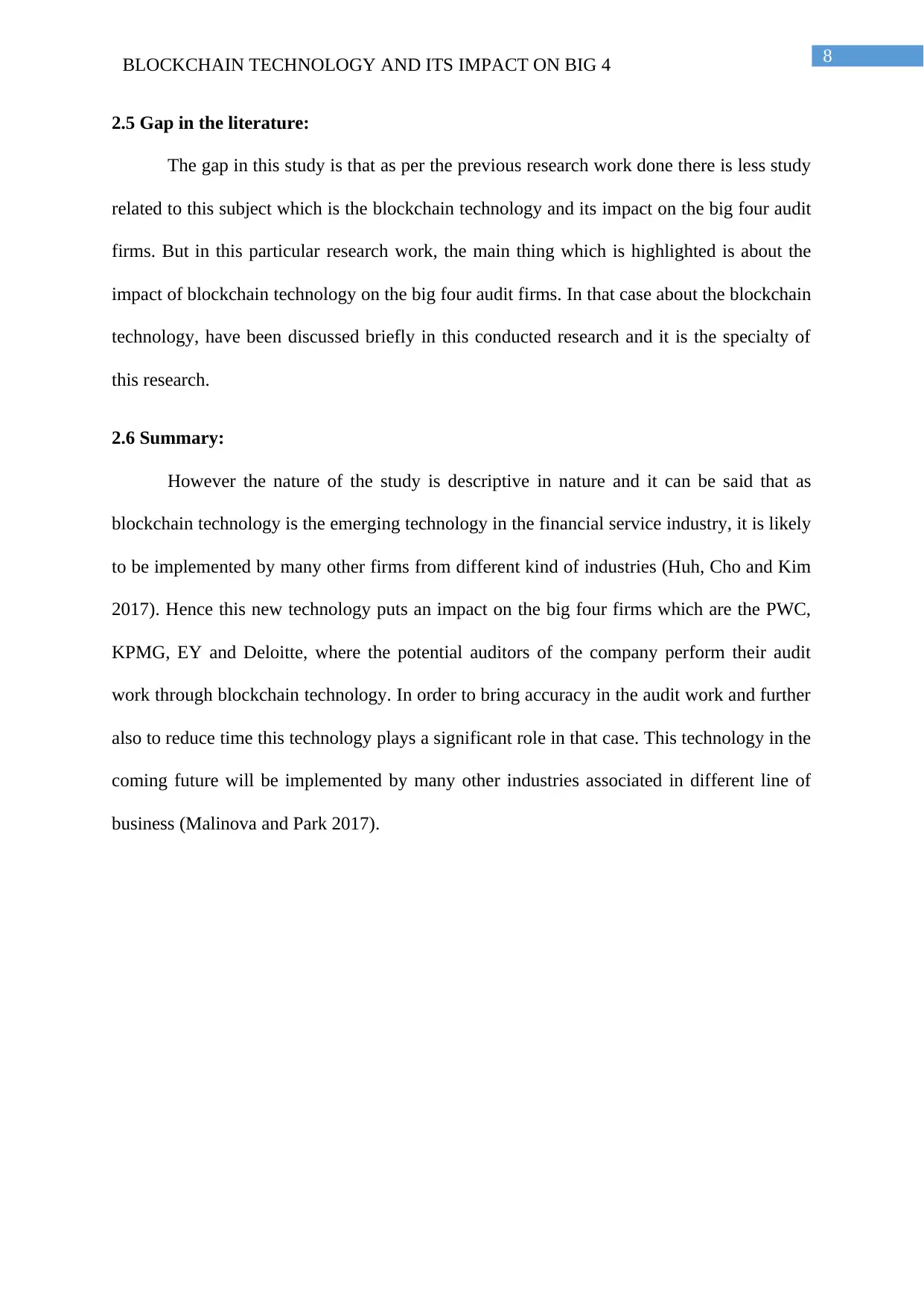
8BLOCKCHAIN TECHNOLOGY AND ITS IMPACT ON BIG 4
2.5 Gap in the literature:
The gap in this study is that as per the previous research work done there is less study
related to this subject which is the blockchain technology and its impact on the big four audit
firms. But in this particular research work, the main thing which is highlighted is about the
impact of blockchain technology on the big four audit firms. In that case about the blockchain
technology, have been discussed briefly in this conducted research and it is the specialty of
this research.
2.6 Summary:
However the nature of the study is descriptive in nature and it can be said that as
blockchain technology is the emerging technology in the financial service industry, it is likely
to be implemented by many other firms from different kind of industries (Huh, Cho and Kim
2017). Hence this new technology puts an impact on the big four firms which are the PWC,
KPMG, EY and Deloitte, where the potential auditors of the company perform their audit
work through blockchain technology. In order to bring accuracy in the audit work and further
also to reduce time this technology plays a significant role in that case. This technology in the
coming future will be implemented by many other industries associated in different line of
business (Malinova and Park 2017).
2.5 Gap in the literature:
The gap in this study is that as per the previous research work done there is less study
related to this subject which is the blockchain technology and its impact on the big four audit
firms. But in this particular research work, the main thing which is highlighted is about the
impact of blockchain technology on the big four audit firms. In that case about the blockchain
technology, have been discussed briefly in this conducted research and it is the specialty of
this research.
2.6 Summary:
However the nature of the study is descriptive in nature and it can be said that as
blockchain technology is the emerging technology in the financial service industry, it is likely
to be implemented by many other firms from different kind of industries (Huh, Cho and Kim
2017). Hence this new technology puts an impact on the big four firms which are the PWC,
KPMG, EY and Deloitte, where the potential auditors of the company perform their audit
work through blockchain technology. In order to bring accuracy in the audit work and further
also to reduce time this technology plays a significant role in that case. This technology in the
coming future will be implemented by many other industries associated in different line of
business (Malinova and Park 2017).
⊘ This is a preview!⊘
Do you want full access?
Subscribe today to unlock all pages.

Trusted by 1+ million students worldwide
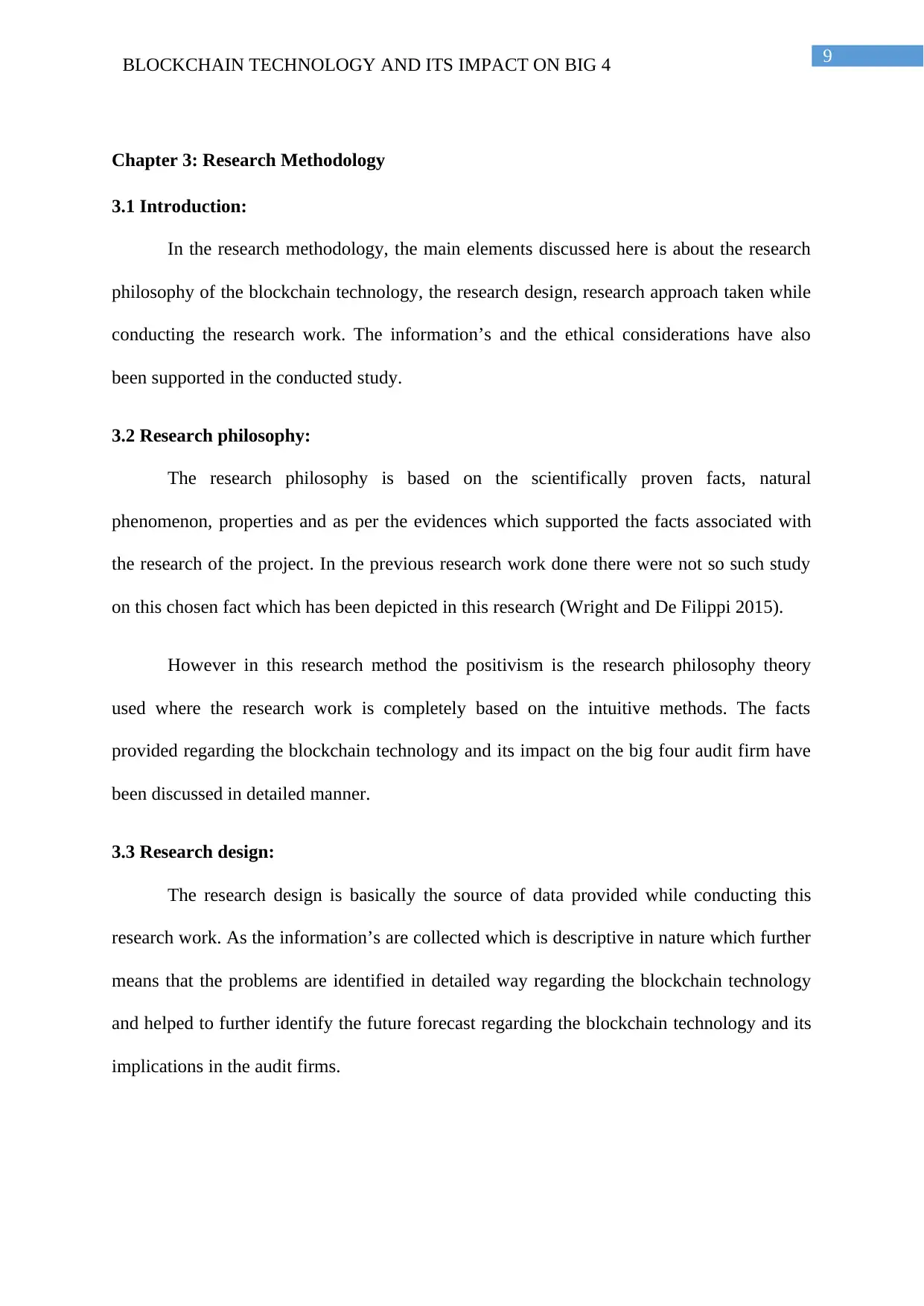
9BLOCKCHAIN TECHNOLOGY AND ITS IMPACT ON BIG 4
Chapter 3: Research Methodology
3.1 Introduction:
In the research methodology, the main elements discussed here is about the research
philosophy of the blockchain technology, the research design, research approach taken while
conducting the research work. The information’s and the ethical considerations have also
been supported in the conducted study.
3.2 Research philosophy:
The research philosophy is based on the scientifically proven facts, natural
phenomenon, properties and as per the evidences which supported the facts associated with
the research of the project. In the previous research work done there were not so such study
on this chosen fact which has been depicted in this research (Wright and De Filippi 2015).
However in this research method the positivism is the research philosophy theory
used where the research work is completely based on the intuitive methods. The facts
provided regarding the blockchain technology and its impact on the big four audit firm have
been discussed in detailed manner.
3.3 Research design:
The research design is basically the source of data provided while conducting this
research work. As the information’s are collected which is descriptive in nature which further
means that the problems are identified in detailed way regarding the blockchain technology
and helped to further identify the future forecast regarding the blockchain technology and its
implications in the audit firms.
Chapter 3: Research Methodology
3.1 Introduction:
In the research methodology, the main elements discussed here is about the research
philosophy of the blockchain technology, the research design, research approach taken while
conducting the research work. The information’s and the ethical considerations have also
been supported in the conducted study.
3.2 Research philosophy:
The research philosophy is based on the scientifically proven facts, natural
phenomenon, properties and as per the evidences which supported the facts associated with
the research of the project. In the previous research work done there were not so such study
on this chosen fact which has been depicted in this research (Wright and De Filippi 2015).
However in this research method the positivism is the research philosophy theory
used where the research work is completely based on the intuitive methods. The facts
provided regarding the blockchain technology and its impact on the big four audit firm have
been discussed in detailed manner.
3.3 Research design:
The research design is basically the source of data provided while conducting this
research work. As the information’s are collected which is descriptive in nature which further
means that the problems are identified in detailed way regarding the blockchain technology
and helped to further identify the future forecast regarding the blockchain technology and its
implications in the audit firms.
Paraphrase This Document
Need a fresh take? Get an instant paraphrase of this document with our AI Paraphraser
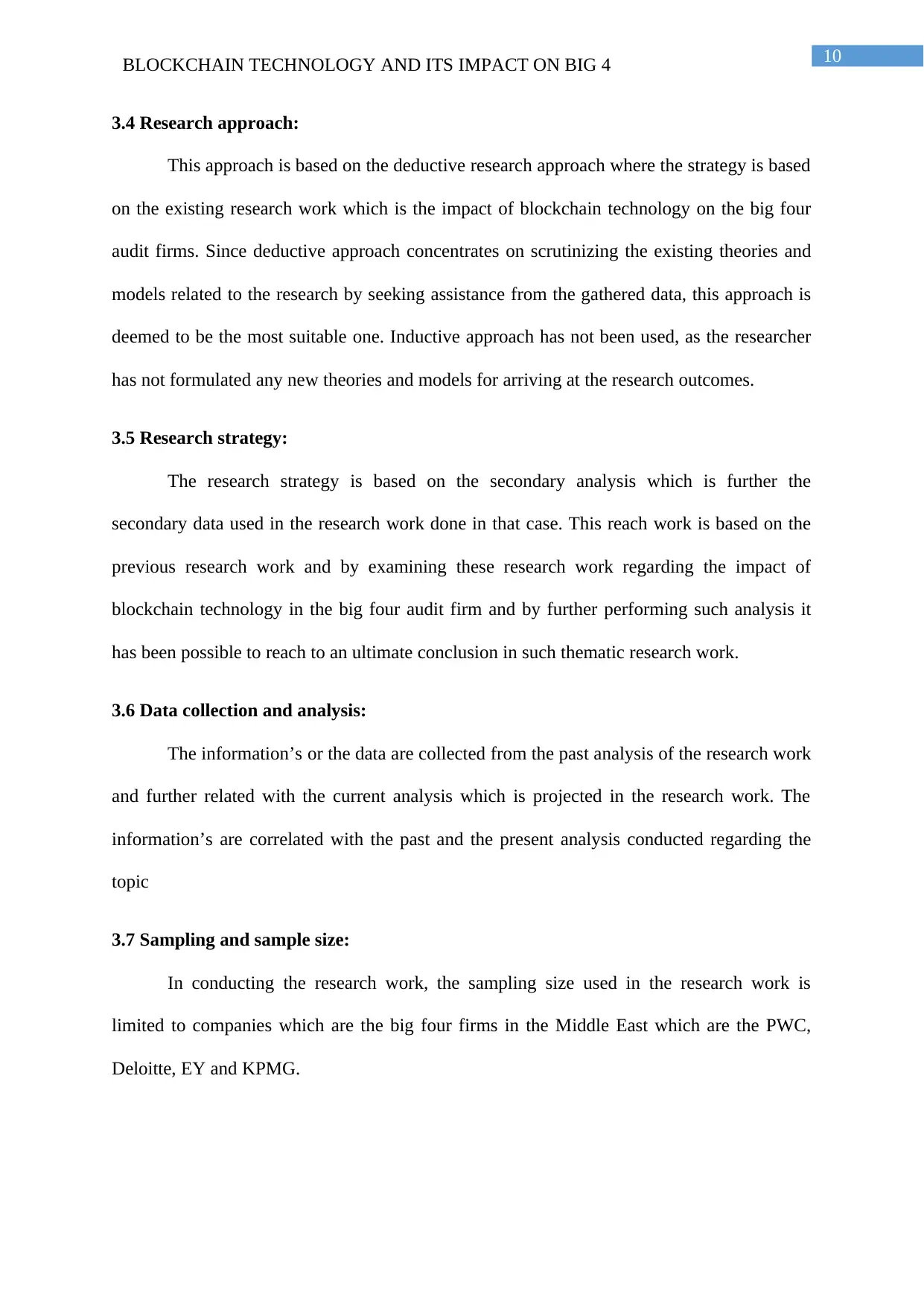
10BLOCKCHAIN TECHNOLOGY AND ITS IMPACT ON BIG 4
3.4 Research approach:
This approach is based on the deductive research approach where the strategy is based
on the existing research work which is the impact of blockchain technology on the big four
audit firms. Since deductive approach concentrates on scrutinizing the existing theories and
models related to the research by seeking assistance from the gathered data, this approach is
deemed to be the most suitable one. Inductive approach has not been used, as the researcher
has not formulated any new theories and models for arriving at the research outcomes.
3.5 Research strategy:
The research strategy is based on the secondary analysis which is further the
secondary data used in the research work done in that case. This reach work is based on the
previous research work and by examining these research work regarding the impact of
blockchain technology in the big four audit firm and by further performing such analysis it
has been possible to reach to an ultimate conclusion in such thematic research work.
3.6 Data collection and analysis:
The information’s or the data are collected from the past analysis of the research work
and further related with the current analysis which is projected in the research work. The
information’s are correlated with the past and the present analysis conducted regarding the
topic
3.7 Sampling and sample size:
In conducting the research work, the sampling size used in the research work is
limited to companies which are the big four firms in the Middle East which are the PWC,
Deloitte, EY and KPMG.
3.4 Research approach:
This approach is based on the deductive research approach where the strategy is based
on the existing research work which is the impact of blockchain technology on the big four
audit firms. Since deductive approach concentrates on scrutinizing the existing theories and
models related to the research by seeking assistance from the gathered data, this approach is
deemed to be the most suitable one. Inductive approach has not been used, as the researcher
has not formulated any new theories and models for arriving at the research outcomes.
3.5 Research strategy:
The research strategy is based on the secondary analysis which is further the
secondary data used in the research work done in that case. This reach work is based on the
previous research work and by examining these research work regarding the impact of
blockchain technology in the big four audit firm and by further performing such analysis it
has been possible to reach to an ultimate conclusion in such thematic research work.
3.6 Data collection and analysis:
The information’s or the data are collected from the past analysis of the research work
and further related with the current analysis which is projected in the research work. The
information’s are correlated with the past and the present analysis conducted regarding the
topic
3.7 Sampling and sample size:
In conducting the research work, the sampling size used in the research work is
limited to companies which are the big four firms in the Middle East which are the PWC,
Deloitte, EY and KPMG.
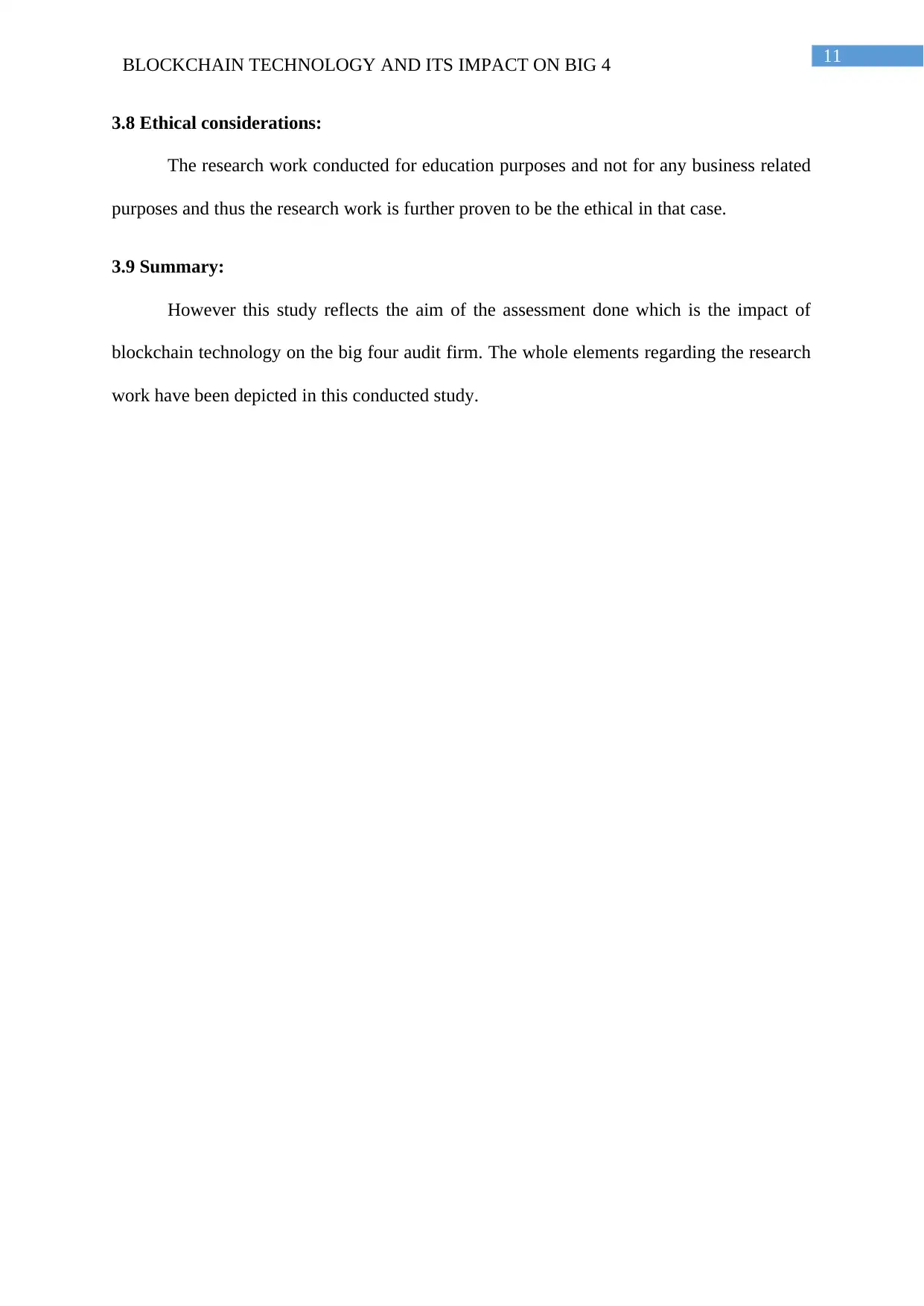
11BLOCKCHAIN TECHNOLOGY AND ITS IMPACT ON BIG 4
3.8 Ethical considerations:
The research work conducted for education purposes and not for any business related
purposes and thus the research work is further proven to be the ethical in that case.
3.9 Summary:
However this study reflects the aim of the assessment done which is the impact of
blockchain technology on the big four audit firm. The whole elements regarding the research
work have been depicted in this conducted study.
3.8 Ethical considerations:
The research work conducted for education purposes and not for any business related
purposes and thus the research work is further proven to be the ethical in that case.
3.9 Summary:
However this study reflects the aim of the assessment done which is the impact of
blockchain technology on the big four audit firm. The whole elements regarding the research
work have been depicted in this conducted study.
⊘ This is a preview!⊘
Do you want full access?
Subscribe today to unlock all pages.

Trusted by 1+ million students worldwide
1 out of 17
Related Documents
Your All-in-One AI-Powered Toolkit for Academic Success.
+13062052269
info@desklib.com
Available 24*7 on WhatsApp / Email
![[object Object]](/_next/static/media/star-bottom.7253800d.svg)
Unlock your academic potential
Copyright © 2020–2025 A2Z Services. All Rights Reserved. Developed and managed by ZUCOL.





